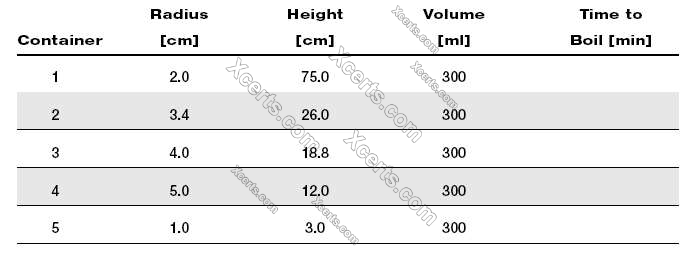Lorna noticed that the amount of time needed to boil water was related to the shape of container she was using. She decided to measure the time necessary to bring 500 ml of water at room temperature to a boil on preheated hotplates. She used five cylindrical 500 milliliter Pyrex glass containers, each having the same wall thickness but a different base radius and height. In other words, some containers were narrow and long, others were wide and shallow. This is the table she prepared to record her data.

She placed each container containing the same amount of water on a hotplate, and placed a thermometer in each one to monitor the temperature. She noticed that the temperature was increasing faster in the containers with a larger radius. After some time, she observed boiling in the 10 cm radius container. She was about to record the time in the table she had set up, but noticed that there seemed to be less water in that container than she originally put in. She transferred the water into a graduated cylinder, and indeed found that the volume was below 300 ml. She proceeded with her experiment. The boiling in container 5 was followed by boiling in containers 4, 3, 2, and 1, in that order. Lorna checked the volume of the water in each container and found that it was lower than 300 ml. She also found that the decrease in volume was highest in the container with the largest radius. In container 1, volume decrease was barely detectable. While the decrease in volumes prevented her from getting meaningful data on boiling, they gave her an idea of how container shapes affect boiling times. In addition, she got an idea for her next project evaporation from containers of different shapes.
The experiment suggests that:
- as the container radius is increased, the time required to boil the water in the container is increased.
- as the container radius is increased, the time required to boil the water in the container is decreased.
- there is no correlation between the container radius and the boiling time for water.
- there may be a correlation between the container radius and the boiling time, but due to the volume decrease, it is not possible to state what the correlation is.
Answer(s): B
Explanation:
Water in container 5, which has the largest radius, boils first. Water in other containers confirms this trend. You may have been tempted to choose D, because of the statement that Lorna was not able to collect quantitative data. However, there seemed to be a clear trend to support B and the statement that she obtained qualitative data means that she was confident that although the exact boiling times could be off, the trend she observed was real.